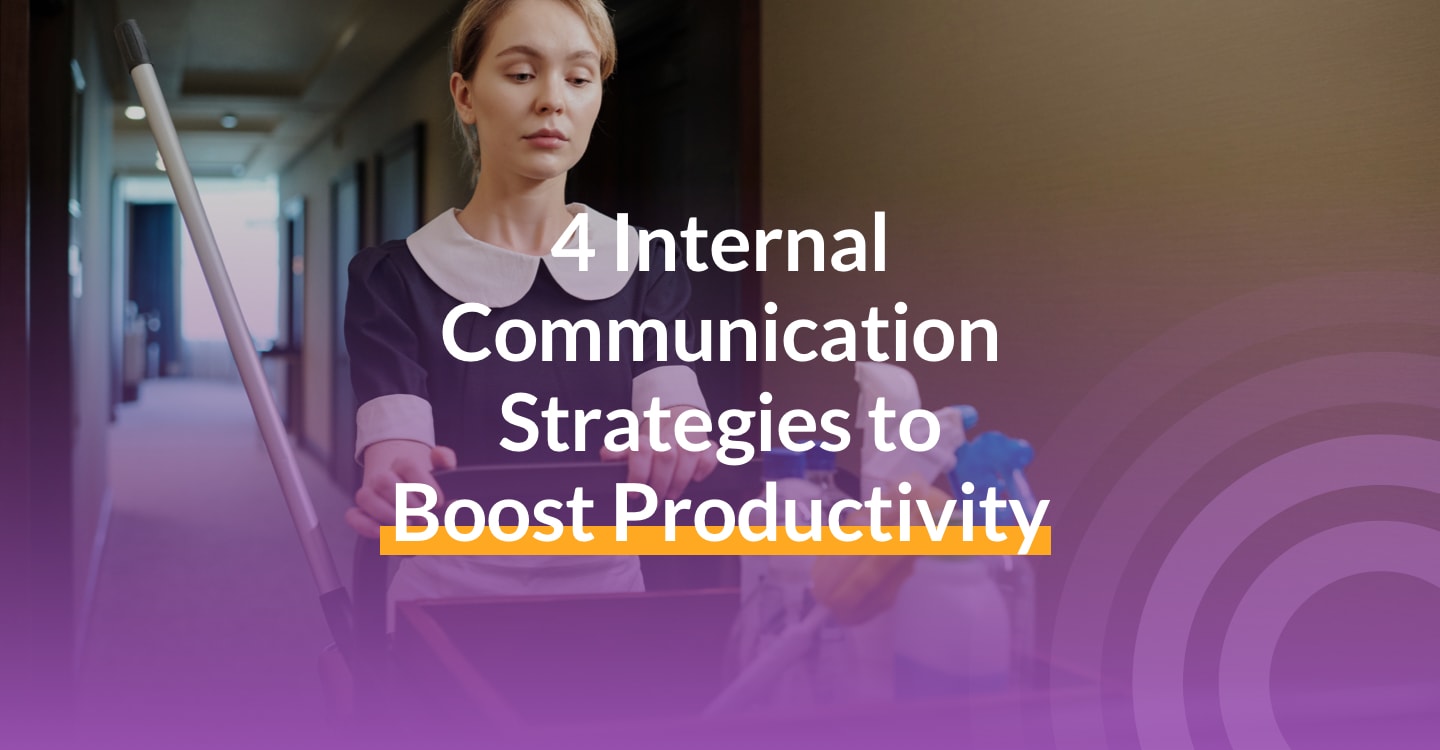Retail Communication Is Broken. And That Might Be Why Your Employees Are Leaving
It’s 6:30 a.m. on Black Friday, and your busiest store is buzzing. Associates show up excited, coffee-fueled, ready to take on the most profitable day of the year. But as soon as the doors open, things fall apart. That’s because:
- HQ pushed through a last-minute change to the return policy, but nobody told the floor team.
- New promotional codes went live online overnight, but all your associates are clueless.
- The “doorbuster” that customers are demanding is already sold out before 9 a.m.
The result? Confused staff, angry customers, and managers scrambling to improvise. By lunchtime, two of your most reliable retail associates are already checking job boards on their phones.
This isn’t just any dramatic story. It’s what poor retail communication looks like in action. It’s the harsh reality in the industry today, and is one of the most overlooked reasons why people are leaving their retail jobs.
In this blog, we’ll unpack why and how poor communication is fueling disengagement and turnover in retail. Read along to discover the real business costs of getting retail comms wrong, and learn practical steps to take to build modern communication pathways that drive engagement and keep your employees around.
Reality check: Retail turnover is at crisis levels, and the culprit is not what you think
Retail is one of the most volatile industries for talent. According to the Bureau of Labor Statistics, the average annual turnover rate hovers around 60%. This is one of the highest across industries.
Most leaders point towards low wages or messy scheduling as the obvious culprits behind the high retail turnover levels. And yes, these factors totally matter; however, when you dig deeper, a hidden, and super essential factor surfaces: broken communication.
Ignoring comms destroys employee engagement in retail, which in turn fuels the turnover crisis everyone’s battling. Studies show that disengagement in retail environments is linked to 12.5% higher shrinkage.
Our point is that communication is engagement. Don’t believe it, just because we’re saying. We’ve got proof. According to studies,
- 71% of retail staff say poor communication is their biggest challenge at work.
- 36% of employees directly link poor communication to job dissatisfaction.
Take a moment to consider what these numbers signify. They clearly give away that employees aren’t just unhappy and leaving because they feel underpaid. They’re deeply annoyed because they’re kept in the dark.
Here’s some context: On retail floors, associates are constantly juggling long lines, unpredictable customers, and constant multitasking. They can’t afford to “catch up later.” They need information in the moment, in their hands, and in a way that fits into their flow of work. When the staff don’t get that, they feel ignored or blindsided, and they disengage. When disengagement transpires, they start doing the bare minimum, stop sharing insights, and eventually stop showing up altogether. On the other hand, companies with high engagement enjoy 59% lower turnover and create significantly higher customer satisfaction.
Where the retail communication gap comes from
We know you’re wondering, if the problem is so obvious, why do so many retailers struggle with comms? Short answer: Because most are still relying on outdated communication tools designed for office environments, or tools that are not for the retail frontline.
Let us be honest: email blasts, bulletin boards, and “tell your team during pre-shift” aren’t enough for retail associates. Neither is Slack. Here’s why they don’t work:
- Emails: Your retail workers don’t sit at desks. They rarely check their work email (if they have it at all)
- Bulletin boards: These updates simply get stashed in the far-flung corner. They are easy to miss and quickly outdated. Unsurprisingly, they’re most ignored altogether.
- Manager pass-downs: With this route, news often gets delayed, distorted, or watered down as it travels through layers of hierarchy.
Long story short: If you’re using these traditional or widely prevalent approaches for retail comms, they’re only going to end up as a corporate version of the whisper game for your associates. By the time your message reaches from the HQ to the floor (if at all), no one knows what the original version was intended to be.
The hidden cost of poor retail communication
Poor retail communication isn’t just frustrating. It’s also (quite) expensive. Let’s quickly go through the top 4 cost drivers:
1.Recruitment drain
According to American Progress, replacing one retail employee costs about 16% of their salary—nearly $5,000 at the median wage in the US. With a 60% turnover, add it up and you’ll see your recruitment budget isn’t just large, it’s ballooning.
2.Training waste
Every departure wipes out onboarding investments and forces stores into a cycle of perpetually training people. This means, instead of building experienced, high-performing teams, you’re always starting over.
3.Customer fallout
Confused staff = confused customers. The result is missed sales opportunities, negative reviews, and reputational damage. Statistically speaking, 77% of leaders confirm that engagement directly impacts customer satisfaction.
4.Lost intelligence
Your frontline workers are usually the first to see retail trends. They’re the ones who know what customers are asking, where they’re hesitating, and what’s flying off shelves. When they leave, or when they don’t have a way to share their first-hand experiences, you lose priceless insights, and that’s expensive!
Add these costs up and you realize something: poor communication isn’t just a random HR issue. It’s a business strategy issue in retail. If your communication is costing you employees, customers, and competitive insights, then upgrading from ancient to modern retail comms is one of the most powerful levers you can(and should) pull for growth and profitability.
What modern retail communication looks like
It’s not more emails or another bulletin board. It’s real-time, mobile-first, two-way. Let’s show you a picture of what it looks like:
Imagine it’s 6 a.m., your regional manager posts new promo details. By 8 a.m., every associate across every location has the update on their phone, complete with FAQs and pricing. Customers ask, and your associates can answer any queries confidently. Retail managers stop firefighting and start leading. Staff feel informed, valued, and connected.
This is totally possible, using a purpose-built communication platform for retail ( like you know, Speakap). Using Speakap for retail comms changes the game by facilitating:
- Real-time updates: You share an update once, and reach everyone instantly—no distortion in the original message.
- Simplified task management: Handing out clear, digital instructions for your retail teams is easy.
- Mobile-first access: You meet staff where they are, on their phones.
- Two-way conversations: Retail associates can flag any customer issues. They can share insights and feel heard.
- Community & recognition: Wins and updates are celebrated instantly, boosting morale across your staff.
Real retailers such as Shell and Takko Fashion, among others, are already seeing promising improvements in their retail comms and engagement using Speakap.
- Shell got 90% of its frontline staff active on the app within weeks, along with an excellent improvement in engagement towards their comms.
- Takko Fashion is successfully keeping its 18,000 frontline employees well-informed across 17 countries, and achieving improved efficiency.
Inspired to close your retail comms gap? Follow these six steps and fix your communication
Here’s a roadmap that you can start implementing today to boost engagement with better retail communication:
1. Audit your current communication flow
Ask frontline staff what they’re missing. Are messages late, irrelevant, or inconsistent? Their answers will reveal where the real cracks lie.
2. Go mobile-first
Your employees live on their phones. Stop fighting it. Instead, embrace it. Use tools designed for fast, accessible communication in retail environments (We mean, Speakap!)
3. Make it a two-way street
Broadcasting announcements in retail isn’t enough. You need to treat comms as a dialogue, not a megaphone.
For that, invest in a culture that encourages employees to ask questions, share feedback, and surface customer insights. Create a space to facilitate that, like a company intranet.
4. Focus on speed and relevance
Time is everything in retail. So, work on delivering the right updates to the right teams at the right moment. Avoid flooding everyone with messages that don’t apply to them. Your Miami store doesn’t need to know about a sale in the NYC store.
5. Measure and iterate
Don’t guess if your comms are working. Track what exactly is going on instead. For that, monitor your employee retention, satisfaction, and operational efficiency levels. You can even conduct pulse audits. Use these insights to continually refine your approach.
6. Recognize and celebrate wins
Remember: Communication isn’t just about instructions. It’s also about recognition. Celebrate your team's successes quickly and visibly, so other employees feel seen and motivated.
Take charge of turnover by ending the retail communication chaos
- Retail is already tough. Accepting high turnover as “just the way it is” makes it even more challenging.
- Communication is the glue that holds everything together. Get it wrong, and you lose employees, customers, and revenue.
- Get it right, and you unlock engagement, loyalty, and growth.
The choice is simple: keep firefighting the same old chaos, or give your frontline the clarity they deserve. If you’re ready for the second option, let’s talk. Speakap helps retailers turn communication into their most significant retention advantage. Find out how it can improve your operations and reverse your turnover. Get a demo
Retail Communication Is Broken. And That Might Be Why Your Employees Are Leaving

It’s 6:30 a.m. on Black Friday, and your busiest store is buzzing. Associates show up excited, coffee-fueled, ready to take on the most profitable day of the year. But as soon as the doors open, things fall apart. That’s because:
- HQ pushed through a last-minute change to the return policy, but nobody told the floor team.
- New promotional codes went live online overnight, but all your associates are clueless.
- The “doorbuster” that customers are demanding is already sold out before 9 a.m.
The result? Confused staff, angry customers, and managers scrambling to improvise. By lunchtime, two of your most reliable retail associates are already checking job boards on their phones.
This isn’t just any dramatic story. It’s what poor retail communication looks like in action. It’s the harsh reality in the industry today, and is one of the most overlooked reasons why people are leaving their retail jobs.
In this blog, we’ll unpack why and how poor communication is fueling disengagement and turnover in retail. Read along to discover the real business costs of getting retail comms wrong, and learn practical steps to take to build modern communication pathways that drive engagement and keep your employees around.
Reality check: Retail turnover is at crisis levels, and the culprit is not what you think
Retail is one of the most volatile industries for talent. According to the Bureau of Labor Statistics, the average annual turnover rate hovers around 60%. This is one of the highest across industries.
Most leaders point towards low wages or messy scheduling as the obvious culprits behind the high retail turnover levels. And yes, these factors totally matter; however, when you dig deeper, a hidden, and super essential factor surfaces: broken communication.
Ignoring comms destroys employee engagement in retail, which in turn fuels the turnover crisis everyone’s battling. Studies show that disengagement in retail environments is linked to 12.5% higher shrinkage.
Our point is that communication is engagement. Don’t believe it, just because we’re saying. We’ve got proof. According to studies,
- 71% of retail staff say poor communication is their biggest challenge at work.
- 36% of employees directly link poor communication to job dissatisfaction.
Take a moment to consider what these numbers signify. They clearly give away that employees aren’t just unhappy and leaving because they feel underpaid. They’re deeply annoyed because they’re kept in the dark.
Here’s some context: On retail floors, associates are constantly juggling long lines, unpredictable customers, and constant multitasking. They can’t afford to “catch up later.” They need information in the moment, in their hands, and in a way that fits into their flow of work. When the staff don’t get that, they feel ignored or blindsided, and they disengage. When disengagement transpires, they start doing the bare minimum, stop sharing insights, and eventually stop showing up altogether. On the other hand, companies with high engagement enjoy 59% lower turnover and create significantly higher customer satisfaction.
Where the retail communication gap comes from
We know you’re wondering, if the problem is so obvious, why do so many retailers struggle with comms? Short answer: Because most are still relying on outdated communication tools designed for office environments, or tools that are not for the retail frontline.
Let us be honest: email blasts, bulletin boards, and “tell your team during pre-shift” aren’t enough for retail associates. Neither is Slack. Here’s why they don’t work:
- Emails: Your retail workers don’t sit at desks. They rarely check their work email (if they have it at all)
- Bulletin boards: These updates simply get stashed in the far-flung corner. They are easy to miss and quickly outdated. Unsurprisingly, they’re most ignored altogether.
- Manager pass-downs: With this route, news often gets delayed, distorted, or watered down as it travels through layers of hierarchy.
Long story short: If you’re using these traditional or widely prevalent approaches for retail comms, they’re only going to end up as a corporate version of the whisper game for your associates. By the time your message reaches from the HQ to the floor (if at all), no one knows what the original version was intended to be.
The hidden cost of poor retail communication
Poor retail communication isn’t just frustrating. It’s also (quite) expensive. Let’s quickly go through the top 4 cost drivers:
1.Recruitment drain
According to American Progress, replacing one retail employee costs about 16% of their salary—nearly $5,000 at the median wage in the US. With a 60% turnover, add it up and you’ll see your recruitment budget isn’t just large, it’s ballooning.
2.Training waste
Every departure wipes out onboarding investments and forces stores into a cycle of perpetually training people. This means, instead of building experienced, high-performing teams, you’re always starting over.
3.Customer fallout
Confused staff = confused customers. The result is missed sales opportunities, negative reviews, and reputational damage. Statistically speaking, 77% of leaders confirm that engagement directly impacts customer satisfaction.
4.Lost intelligence
Your frontline workers are usually the first to see retail trends. They’re the ones who know what customers are asking, where they’re hesitating, and what’s flying off shelves. When they leave, or when they don’t have a way to share their first-hand experiences, you lose priceless insights, and that’s expensive!
Add these costs up and you realize something: poor communication isn’t just a random HR issue. It’s a business strategy issue in retail. If your communication is costing you employees, customers, and competitive insights, then upgrading from ancient to modern retail comms is one of the most powerful levers you can(and should) pull for growth and profitability.
What modern retail communication looks like
It’s not more emails or another bulletin board. It’s real-time, mobile-first, two-way. Let’s show you a picture of what it looks like:
Imagine it’s 6 a.m., your regional manager posts new promo details. By 8 a.m., every associate across every location has the update on their phone, complete with FAQs and pricing. Customers ask, and your associates can answer any queries confidently. Retail managers stop firefighting and start leading. Staff feel informed, valued, and connected.
This is totally possible, using a purpose-built communication platform for retail ( like you know, Speakap). Using Speakap for retail comms changes the game by facilitating:
- Real-time updates: You share an update once, and reach everyone instantly—no distortion in the original message.
- Simplified task management: Handing out clear, digital instructions for your retail teams is easy.
- Mobile-first access: You meet staff where they are, on their phones.
- Two-way conversations: Retail associates can flag any customer issues. They can share insights and feel heard.
- Community & recognition: Wins and updates are celebrated instantly, boosting morale across your staff.
Real retailers such as Shell and Takko Fashion, among others, are already seeing promising improvements in their retail comms and engagement using Speakap.
- Shell got 90% of its frontline staff active on the app within weeks, along with an excellent improvement in engagement towards their comms.
- Takko Fashion is successfully keeping its 18,000 frontline employees well-informed across 17 countries, and achieving improved efficiency.
Inspired to close your retail comms gap? Follow these six steps and fix your communication
Here’s a roadmap that you can start implementing today to boost engagement with better retail communication:
1. Audit your current communication flow
Ask frontline staff what they’re missing. Are messages late, irrelevant, or inconsistent? Their answers will reveal where the real cracks lie.
2. Go mobile-first
Your employees live on their phones. Stop fighting it. Instead, embrace it. Use tools designed for fast, accessible communication in retail environments (We mean, Speakap!)
3. Make it a two-way street
Broadcasting announcements in retail isn’t enough. You need to treat comms as a dialogue, not a megaphone.
For that, invest in a culture that encourages employees to ask questions, share feedback, and surface customer insights. Create a space to facilitate that, like a company intranet.
4. Focus on speed and relevance
Time is everything in retail. So, work on delivering the right updates to the right teams at the right moment. Avoid flooding everyone with messages that don’t apply to them. Your Miami store doesn’t need to know about a sale in the NYC store.
5. Measure and iterate
Don’t guess if your comms are working. Track what exactly is going on instead. For that, monitor your employee retention, satisfaction, and operational efficiency levels. You can even conduct pulse audits. Use these insights to continually refine your approach.
6. Recognize and celebrate wins
Remember: Communication isn’t just about instructions. It’s also about recognition. Celebrate your team's successes quickly and visibly, so other employees feel seen and motivated.
Take charge of turnover by ending the retail communication chaos
- Retail is already tough. Accepting high turnover as “just the way it is” makes it even more challenging.
- Communication is the glue that holds everything together. Get it wrong, and you lose employees, customers, and revenue.
- Get it right, and you unlock engagement, loyalty, and growth.
The choice is simple: keep firefighting the same old chaos, or give your frontline the clarity they deserve. If you’re ready for the second option, let’s talk. Speakap helps retailers turn communication into their most significant retention advantage. Find out how it can improve your operations and reverse your turnover. Get a demo
Manténgase actualizado con las últimas tendencias e información directamente en su bandeja de entrada.











